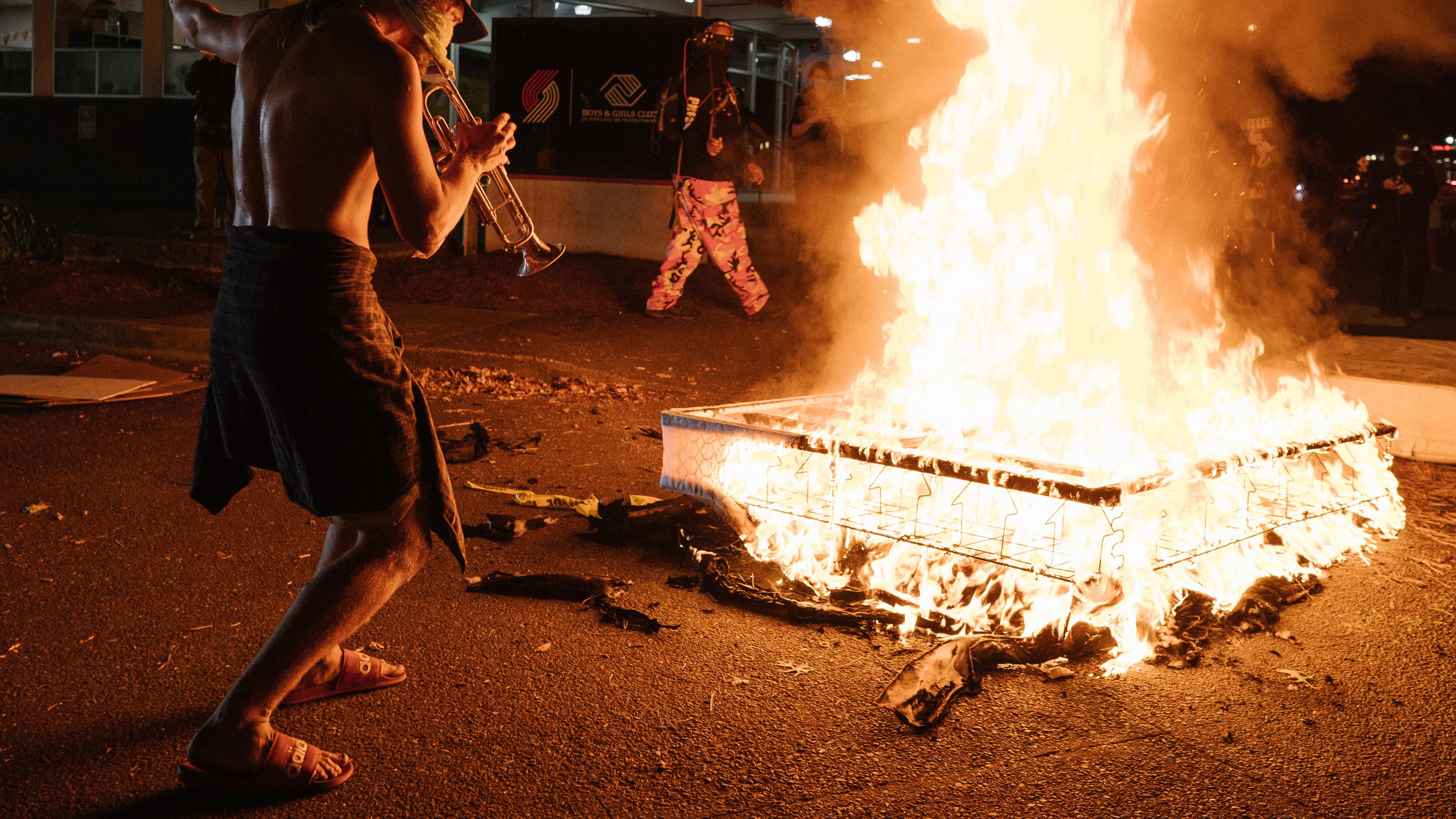Multnomah County prosecutors have made good use of Oregon’s riot statute in recent years. Nearly 100 people were charged with it in 2020 alone. But as cases stemming from that summer’s protests wind their way through the courts, Portland criminal defense lawyers are questioning whether it’s constitutional.
They argue the law violates the First Amendment, effectively making it a felony to be in the wrong place at the wrong time.
The 50-year-old law, Oregon Revised Statute 166.015, is deceptively simple: It is a crime for “five or more” people to create “a grave risk of causing public alarm” through violence or tumultuous conduct.
But its application has proved daunting for prosecutors and judges, who are trying to distinguish between rioter, provocateur and protester.
Earlier this year, when Multnomah County District Attorney Mike Schmidt’s office attempted to prosecute Joey Gibson, founder of the right-wing activist group Patriot Prayer, and an associate, Russell Schultz, solely on riot charges for their involvement in a street brawl, the judge balked.
“The state is trying to convict Mr. Schultz for being present at an incident that violence occurred, and they cannot do so,” Judge Benjamin Souede said in July.
Challenges to the law’s constitutionality are not new. A trial court threw it out more than 20 years ago—only to have the Oregon Supreme Court reinstate it in 1997.
But much has changed in the intervening two decades, says public defender Emma McDermott, who wrote a legal brief in October arguing the state law is unconstitutional. McDermott says the law is vague, giving police broad justification to make arrests, and prosecutors leverage to tack on a felony charge and pressure defendants into plea deals.
In recent months, that brief has repeatedly been used in defense of people charged with rioting on Portland’s streets. Here are three cases in which McDermott’s brief has been cited in criminal proceedings.
State of Oregon v. Camillo Charles Massagli
Sept. 6, 2020, the 101st night of protests in Portland, was no different than any of the other nights, Camillo Massagli says.
Massagli is better known as the “Trumpet Man” for his musical shows of civil disobedience. That night, Massagli played his grandfather’s trumpet in front of a burning mattress outside the Portland Police Bureau’s North Precinct.
There were “record-breaking” winds that night, prosecutors say. And the county had instituted a fire ban. Police, worried about blowing embers, forcibly removed protesters from the area, and firefighters extinguished the blaze.
Police later identified the man who had started the fire, Adam Layee. An officer saw him light the mattress. (Layee pleaded guilty in March 2022.) Massagli was accused of helping. The two were arrested later that night for “reckless burning,” along with 13 others on various other charges.
Reckless burning is a class A misdemeanor, the equivalent of a DUII. But prosecutors tacked on felony charges as well: the crime of riot.
In October, defense lawyers filed legal briefs challenging the constitutionality of the riot charge. And in November, Massagli pleaded guilty to riot—but with effectively no consequences. Prosecutors say they will drop all of the charges if he avoids arrest and then withdraws his plea in six months.
Massagli lost his dream job as a wilderness guide and became homeless as a result of his legal troubles, he says. He was looking forward to the chance to clear his name in court, but prosecutors’ offer was too good to turn down. “The state came back with an incredibly good deal.” Massagli says. “I couldn’t refuse.”
State of Oregon v. Theodore Matthee-O’Brien
Matthee-O’Brien became infamous when Mayor Ted Wheeler publicly called for his expulsion from Reed College in the wake of a night of broken windows at the Oregon Historical Society on April 16, 2021.
“If that individual is convicted, I hope he’s expelled,” Wheeler said in a statement at the time.
Well, Matthee-O’Brien has now been convicted of a crime. But not, perhaps, the one Wheeler expected.
Matthee-O’Brien has long proclaimed his innocence in court filings. An FBI agent identified Matthee-O’Brien as the window smasher. But police reports identify another suspect, Cameron Millar-Griffin, who was caught on video smashing the windows with a small, black tool while carrying a distinctive bag. (He later paid more than $5,681 in restitution to the Historical Society after pleading guilty to riot and criminal mischief.)
Both men were arrested later that night and charged with riot. Matthee-O’Brien was caught carrying the bag—and the tool.
In October, his attorney filed a constitutional objection to the riot charge, echoing McDermott’s argument. A few weeks later, he pleaded guilty—but not to the window smashing. Instead, he was convicted of “interfering with a police officer” in a separate incident. On the day of President Joe Biden’s inauguration, Jan. 20, 2021, Matthee-O’Brien carried a shield, prosecutors wrote, and used it to shove cops who were pushing their way into a crowd.
“They just tacked the rioting charges on to overwhelm me and pressure me into taking a plea deal,” Matthee-O’Brien tells WW. “And it worked.”
Prosecutors promised to dismiss the riot charge if Matthee-O’Brien performs 80 hours of community service and stays out of trouble for the next six months. Matthee-O’Brien obtained his anthropology degree as the case was being litigated. Neither Reed College nor the city was willing to comment further.
State of Oregon v. Brandon Paul Bartells
Brandon Bartells was arrested in the driver’s seat of a white graffiti-covered van that police had just seen pull down statues of Theodore Roosevelt and Abraham Lincoln in downtown Portland. It was during the “Indigenous Peoples Day of Rage” protest on Oct. 11, 2020, the night before Columbus Day. Bartells was one of six people in the van but the only person charged.
The state’s case has weaknesses. Guy Gino, a special agent with the Department of Homeland Security, witnessed the toppling of the statues. He identified Bartells as the driver after being shown a photo depicting Bartells already in handcuffs behind a sign reading “Guy in truck who pulled down statue,” according to a motion filed by Bartell’s attorney, Sean Lo. Lo argues the identification is tainted and should be thrown out.
Bartells pleaded not guilty to charges of riot and criminal mischief. His case is scheduled to go to trial in December. Bartell’s attorneys filed a brief challenging the law’s constitutionality Nov. 15, leaving open the possibility that the riot statute could be challenged on appeal.
The city has valued the damage to the statues at $30,000, an amount Bartells could be forced to pay if he is convicted. The statues remain in storage.

